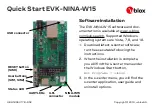Serial Communication Interface (S12SCIV5)
MC9S12XHY-Family Reference Manual, Rev. 1.01
Freescale Semiconductor
481
indicating that the received byte can be read. If the receive interrupt enable bit, RIE, in SCI control
register 2 (SCICR2) is also set, the RDRF flag generates an RDRF interrupt request.
14.4.6.3
Data Sampling
The RT clock rate. The RT clock is an internal signal with a frequency 16 times the baud rate. To adjust
for baud rate mismatch, the RT clock (see
Figure 14-21
) is re-synchronized:
•
After every start bit
•
After the receiver detects a data bit change from logic 1 to logic 0 (after the majority of data bit
samples at RT8, RT9, and RT10 returns a valid logic 1 and the majority of the next RT8, RT9, and
RT10 samples returns a valid logic 0)
To locate the start bit, data recovery logic does an asynchronous search for a logic 0 preceded by three logic
1s.When the falling edge of a possible start bit occurs, the RT clock begins to count to 16.
Figure 14-21. Receiver Data Sampling
To verify the start bit and to detect noise, data recovery logic takes samples at RT3, RT5, and RT7.
Figure 14-17
summarizes the results of the start bit verification samples.
If start bit verification is not successful, the RT clock is reset and a new search for a start bit begins.
Table 14-17. Start Bit Verification
RT3, RT5, and RT7 Samples
Start Bit Verification
Noise Flag
000
Yes
0
001
Yes
1
010
Yes
1
011
No
0
100
Yes
1
101
No
0
110
No
0
111
No
0
Reset RT Clock
RT
1
RT
1
RT
1
RT
1
RT
1
RT
1
RT
1
RT
1
RT
1
RT
2
RT
3
RT
4
RT
5
RT
8
RT
7
RT
6
R
T11
R
T10
RT
9
R
T15
R
T14
R
T13
R
T12
R
T16
RT
1
RT
2
RT
3
RT
4
Samples
RT Clock
RT CLock Count
Start Bit
RXD
Start Bit
Qualification
Start Bit
Data
Sampling
1
1
1
1
1
1
1
1
0
0
0
0
0
0
0
LSB
Verification
electronic components distributor


















